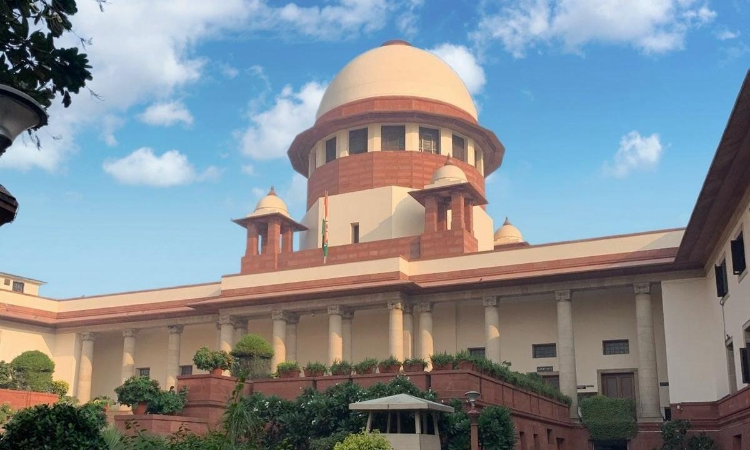- Home
- /
- Top Stories
- /
- Andhra Pradesh, Telangana Assembly:...
Andhra Pradesh, Telangana Assembly: SC Issues Notice on Plea to Implement S.26 of 2014 Reorganisation Act and Increase No. of Seats
Awstika Das
20 Sept 2022 9:56 AM IST
A Division Bench of the Supreme Court of India on Friday issued notice on a writ petition seeking the implementation of Section 26 of the Andhra Pradesh Reorganisation Act, 2014. This Section provides that the number of seats in the legislatures of the successor states of Andhra Pradesh and Telangana would be increased from 175 and 119 to 225 and 153 respectively. It has also been contended...
A Division Bench of the Supreme Court of India on Friday issued notice on a writ petition seeking the implementation of Section 26 of the Andhra Pradesh Reorganisation Act, 2014. This Section provides that the number of seats in the legislatures of the successor states of Andhra Pradesh and Telangana would be increased from 175 and 119 to 225 and 153 respectively. It has also been contended that delimiting the assembly and parliamentary constituencies of only the newly minted union territory of Jammu and Kashmir has created an unreasonable classification, and the non-inclusion of Andhra Pradesh and Telangana in the process is, therefore, unconstitutional.
This public interest litigation has been filed by Professor (Dr.) K. Purushottam Reddy. A Bench comprising Justices K.M. Joseph and Hrishikesh Roy has sought responses from the respondents, viz., the Union of India, the states of Andhra Pradesh and Telangana, and the Election Commission of India.
Background
74 years ago, on September 17, 1948, the erstwhile princely state of Hyderabad was annexed by India, following a brief struggle that lasted 109 hours. The invasion of Hyderabad by India, or 'Operation Polo', as it was christened, came on the heels of the alleged violations of the standstill agreement signed between India and the Nizam of Hyderabad, by the latter. In 1953, after its annexation, the State Reorganisation Committee had recommended that the Telegu-dominant Telangana region be recognised as a separate state at least in the interim period. However, in 1956, driven by desires to create 'Visalandhra', the Government merged Andhra State and Telangana into a single state called Andhra Pradesh, with Hyderabad as its capital. However, the call for Telangana statehood has persisted since the time of Independence, often turning violent.
Finally, in 2014, after years of political strife, the Parliament approved the creation of Telangana comprising 10 districts from north-western Andhra Pradesh by enacting the Andhra Pradesh Reorganisation Act.
Section 26(1) of the act states that, inter alia, subject to the provisions contained in Article 170 of the Constitution and without prejudice to Section 15 of the Act, the number of seats in the Legislative Assembly of the successor States of Andhra Pradesh and Telangana would be increased from 175 and 119 to 225 and 153, respectively. However, Article 170(3) of the Constitution enjoins the Government from readjusting the total number of seats in the Assembly of each State until after the publication of the first Census after 2026.
In response to an unstarred question asked on July 27, 2022 by Member of Parliament (Rajya Sabha) G.V.L. Narasimha Rao on the implementation of Section 26 and the time frame thereof, the Minister of Home Affairs answered –
"Unless and until Article 170 of the Constitution is amended in line with Section 26 of Andhra Pradesh Reorganisation Act, 2014, the number of seats cannot be increased."
In the meantime, after the abrogation of Article 370, which resulted in the revocation of the temporary special status conferred on the erstwhile state of Jammu and Kashmir, and the creation of the union territories of Jammu and Kashmir and Ladakh, a Delimitation Commission was set up in March 2020 to redraw or adjust the limits or boundaries of territorial constituencies for the union territory of J&K. In the process, seven new Assembly seats were increased – six in Jammu, and one in Kashmir. Resultantly, the Union Government courted controversy because, among other reasons, the exercise was undertaken despite delimitation generally being carried out on the basis of census population.
Grounds of Challenge
The two major thrusts of the petitioner's argument are that first, the respondents have not taken "all necessary measures in furtherance of Section 26 of the Andhra Pradesh Reorganisation Act, 2014" and second, the process of delimitation conducted in the union territory of Jammu and Kashmir was unconstitutional inasmuch as it has created an unreasonable classification, apart from being arbitrary and discriminatory, therefore, violating Articles 14, 19 and 21 of the Constitution of India. The petitioner claimed –
"The Respondents, therefore, should immediately set in motion the delimitation process to expeditiously increase the number of assembly seats in Andhra Pradesh and Telangana from 175 and 119 to 225 and 153 respectively, as provided in the Andhra Pradesh Reorganisation Act, 2014."
In his petition, Professor Reddy has sought the issuance of a writ of mandamus directing the respondents to implement and take all necessary measures to operationalise Section 26. He has also prayed for a declaration that the delimitation exercise that was conducted for Jammu and Kashmir was unconstitutional since the states of Andhra Pradesh and Telangana were excluded.
Click Here To Read/Download Order


